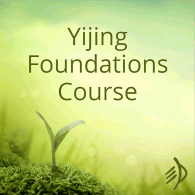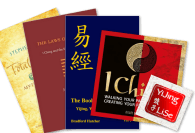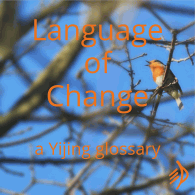Hexagram 36, Brightness Hiding, might be one of the easiest to connect with. Isn’t there a story in the Sorrells’ I Ching Made Easy of someone in an abusive relationship who received Hexagram 36 and broke down in tears of recognition and relief when she heard the story of Ji – feigning madness to avoid the attention of a dangerous, oppressive regime?
And in less extreme situations, too, we can recognise the experience of light wounded and the wisdom of hiding it under a bushel at times. Ji’s strategy is mirrored in the trigram picture, too: the trigram li, fire and light, is hidden away under the earth. We might think of light under a bushel. or banking up a fire to protect it, or just of the cycle of night and day. In any case, it’s a picture we can relate to.
But what about the pheasants?
However… if you look at the work of almost any of the translators who concentrate on recapturing the original, Bronze Age meaning of the text, this simple, relatable picture more or less disappears. Originally, it seems, the hexagram name didn’t mean ‘Brightness Hiding’ at all, but
- Crying Pheasant (Rutt)
- The Calling Arrow-Bird (Field)
- Pelican Calling (Minford book 2)
- Calling Pheasant (Redmond)
Prince Ji is still there in line 5, but the hexagram name no longer has much to do with him. It’s been re-translated: ming 明 means ‘pheasant’; yi 夷 means ‘calling’.
And this has the benefit of making some of the moving lines much more intelligible. Only compare line 1 –
‘Darkening of the light during flight.
(Wilhelm/Baynes)
He lowers his wings…’
to
‘A crying pheasant, flying on drooping wing.’
(Rutt)
Or line 4:
‘He penetrates the left side of the belly.
(Wilhelm/Baynes)
One gets at the very heart of darkening of the light.’
with
‘Entering the left flank, finding the crying pheasant’s heart.’
(Rutt)
Pheasants have wings and hearts and are hunted (line 3); ‘wounded light’ just doesn’t work in the same way. The translation that makes the most sense with the least explanation must be the right one, surely…?
But what about the readings
Only… where does this leave our confident, natural response to a hexagram called ‘Brightness Hiding’? Imagine if the Sorrells had told their querent that her pheasant was crying…
To start with, the pheasant works rather less well in line 5:
‘Darkening of the light as with Prince Chi’
(Wilhelm/Baynes)
vs
‘Jizi’s crying pheasant.’
(Rutt)
Is he supposed to have kept one as a pet?
Also, the reason why it’s said to be impossible for the hexagram to have meant ‘Brightness Hiding’ originally seems fragile to me. Here’s Redmond:
“The Wilhelm-Baynes translation as “Darkening of the Light” is poetic, but clearly incorrect. …This cannot have been the early meaning because, as emphasized previously, there is no evidence for trigram correlations before the Zuozhuan and Ten Wings.”
He’s confused the absence of evidence with evidence of absence, of course. Also, the very earliest manuscripts we have of the Yi tend to show the hexagrams written as two trigrams, with a gap between. Also, we know from the text how often line 3 is a dangerous place because it’s on one side of that gap.
It doesn’t follow that the trigrams originally had all the meanings that have accrued to them since – the lists in the Shuogua, for instance. Indeed, we can be pretty sure they hadn’t, since the imagery of the text doesn’t fit. However, there’s plenty of evidence to suggest that hexagrams have been understood as two trigrams for a long, long time.
And on that note, the two characters from the hexagram name, ming (‘Brightness’ / ‘pheasant’) and yi (‘hiding’ or ‘wounded’ / ‘calling’), are used both together and separately in the moving lines of this hexagram. In line 2:
‘Brightness hidden, wounded in the left thigh.
For rescue, use the power of a horse.
Good fortune.’
That’s ‘ming yi, yi in the left thigh.’ No-one is translating that as ‘calling in the left thigh.’
And line 6:
‘Not bright, dark.
At first rises up to heaven,
Later enters into the earth.’
That’s ‘not ming, dark…’ – and no-one translates as ‘not pheasant, dark’ either. So the meanings of ‘brightness’ and ‘hiding/wounded’ have not been altogether banished.
It all depends…
So which is the right translation? ‘Brightness Hiding/Wounded’ or ‘Calling Pheasant’? I think it all depends on what you are trying to translate. For a couple of millennia – at least since the time the Image was written – Yi has used this hexagram to talk to people about wounded, hidden light. So do you try to translate what the Yi is probably saying to people now, or what the original authors were trying to say 3,000 years ago? Both are valid; both are valuable; they’re just translating different things.
But wait…
However… (this post is full of ‘however’s!) the original authors of the oracle were not trying to communicate anything, or not in the same way any other author might be. They did not set out to convey information to their listeners or readers about either pheasants or wounded light: they were creating a language for an oracle to communicate in.
And that oracular language stems from an oral tradition of sayings and stories. Readings are spoken aloud: they would have been originally, and they are now: I still never do a live reading without reading out the text, and I encourage people reading for themselves to read their question and the oracle’s answer out loud. People need to hear their question being answered.
And spoken language naturally includes wordplay. Thinking in terms of written language, we refer to homophones: distinct, different words that sound the same, like ‘hoarse’ and ‘horse’. Starting with spoken language, it might be better to think of sounds that have more than one meaning.
Chinese is full of these sounds, and they’re not only used for groan-worthy humour, as they are in English, but carry real power. Have a look at this Wikipedia section about the influence of homophones on Spring Festival traditions and you’ll see what I mean.
So…

… is that a duck or a rabbit? It depends how you look at it. And is ming yi a wounded light or a calling pheasant?
Perhaps we can leave the binary either/or behind altogether. The pheasant in question, by the way, is probably the golden pheasant, Chrysolophus pictus: a spectacularly colourful bird that screeches loudly. And yet it’s said to be ‘timid‘, fond of hiding in dense undergrowth, and ‘surprisingly difficult to find‘. A bird that hides its brightness, in fact.
Since Chinese is so good at wordplay in general, the Yijing text is probably full of duckrabbits I know nothing about. But isn’t it apt that this hexagram – with its play of lighting-up and hiding – should be one? The vivid golden pheasant vanishes into the undergrowth and screeches. Prince Ji hid his light, which is perfectly visible to us 3,000 years on. Hexagram 36: the Calling Hiding Bright Pheasant.









